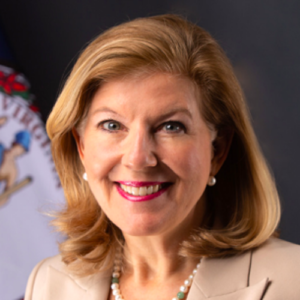Closing Education’s ‘Honesty Gap’: All Hands On Deck to Accelerate Innovation, Embrace High Standards & Offer Parents Greater Transparency
Guidera: The pandemic simply illuminated & exacerbated what’s been happening in education for years: the dismantling of a culture of high expectations

Get stories like this delivered straight to your inbox. Sign up for The 74 Newsletter
This essay was originally published as part of the Center on Reinventing Public Education’s 2023 “State of the American Student” report. As part of the effort, CRPE asked 14 experts from various sectors to offer up examples of innovations, solutions or possible paths forward as education leaders navigate the current crisis. (See all the perspectives)
It’s time to bring back the coffee cups!
When I first attended the annual meeting of the Education Commission of the States in the early 1990s, they were handing out coffee cups with an exhortation that “all kids can learn.” I remember thinking, duh, of course they can. The standards movement was in full bloom at the time, and the statement seemed like a no-brainer.
No longer. The pandemic merely illuminated and exacerbated what has been happening in American education for years: the systematic dismantling of a culture of high expectations. Rather than continuing to work together to help all children meet these high standards, which had been the national focus for a few decades, too many state leaders have settled for moving the goalposts, lowering the standards, and pretending that everything was okay. It isn’t.
Combating historic declines with a commitment to excellence, opportunity and innovation
On the most recent National Assessment of Educational Progress (NAEP), Virginia had a 13-point drop in fourth-grade reading since 2017 (the largest reading decline in the nation) and a 12-point drop in fourth-grade math (tied with Maryland as the largest math decline). Both declines are nearly three times the national average in learning loss, and they began before the pandemic as previous administrations lowered expectations across the board. The pandemic worsened everything, of course. As a result, we’re on the verge of losing an entire generation of students.
This tragic reality has fueled our sense of urgency and commitment to change in Virginia. Nothing but boldness will suffice. We know that Virginia has excellent schools, but not every student and family has access to that excellence. We are relying on a much broader set of innovative solutions, and tapping into the expertise of educators and community partners to ensure that every student can attend a school that prepares them for success in life.
For example, 19 (and counting) partnerships have applied to take advantage of the $100 million we have earmarked for Lab Schools, which will stimulate innovative approaches to teaching and learning; encourage greater collaboration among K-12, postsecondary, business and other community partners; and develop model programs that can be replicated. In Southwest Virginia, public schools, community colleges, and local hospitals are collaborating to develop a school to prepare students for careers in health care, which will help support these traditionally underserved communities. On the eastern shore, NASA, Virginia Space, the local community college, and aerospace companies are working with K-12 school districts to launch an aerospace-focused school as part of the goal to make the area the “space hub of the east coast.” Efforts like these are breaking down the walls between education and work, blowing up the one-size-fits-all approach to education, and providing students, especially those who have been marginalized in the past, exposure to the careers of the future.
To help support and accelerate efforts such as these, we’ve created an Office of Innovation within the Virginia Department of Education. This office will not only catalog innovative approaches throughout Virginia, but also network and learn from them so we can replicate success in every corner of the commonwealth. Together with education stakeholders, we will continue to dive into the important and tough questions such as:
- Why doesn’t the commonwealth have more Thomas Jefferson High Schools, the highly acclaimed STEM school, when the waiting list shows huge demand for many more?
- Why are colleges lowering admissions standards at the end of students’ K-12 journeys, when it is much more effective (and fair) to focus on challenging them and preparing them from their earliest years? That’s why we are rethinking gifted/talented and similar programs to provide historically underrepresented kids access to educational opportunities that some children have always had. In addition, the Virginia Literacy Act is revamping how we teach all students to read—ensuring that all instructional materials, professional development, licensure, and teacher prep are based in the science of reading by the 2024-25 school year.
- What can we learn from the new tutoring and mentoring partnerships among K-12, the Urban League, and historically Black colleges and universities in the Petersburg and Hampton Roads areas that can be scaled statewide and nationally?
Empowering families
Parents matter. They deserve to not only have a seat at the table, but to be at the head. We are proactively empowering parents with more actionable information and greater options for their child to access excellence.
Parents have inflated perceptions of student achievement. National research documents that 90% of parents believe their child is at or above grade level in reading and math. In reality, only 37% of students nationally perform at or above grade level in reading and math—a 53% gap between parent perception and reality. This is largely due to a lack of transparency around student proficiency and a dearth of effective communication with parents.
Therefore, Virginia is preparing data reports that tell the truth about where every student and school stands. This year, for the first time ever, schools sent every parent and teacher the same understandable, actionable academic proficiency report, showing a clear picture of how their students were performing and offering discussion topics to support student success. The Virginia Department of Education has also created a complementary online portal, Virginia’s Visualization and Analytics Solution (VVAAS), which includes easy-to-read charts and tables showing a student’s performance compared to their peers.
Thanks to a work group created in our latest legislative session, we are developing an online parent portal that will give parents quality information so they are informed champions and partners in their children’s education. The State Board of Education is also revising our school accreditation system so that there is clear, easy-to-digest information about the academic proficiency and progress of students in every K-12 school in the commonwealth.
We are using data as a flashlight, not a hammer, to inform better decisions at kitchen tables, classrooms, school boards, and the State Capitol. A professional learning community of 25 school districts is helping us develop tools and supports to use this data effectively. Our goal is for every off-track student to have a personalized learning plan with a set of actions to address learning gaps. These plans will be developed and implemented in partnership with teachers, parents, and students. We’ll also train teachers on how to communicate with parents and students about the steps to get a student to grade-level proficiency.
To combat the drastic impact of COVID-19 school closures on students’ educational progress and address the earlier decline in proficiency, we provided $63 million in grants to help families access tutoring services this summer. We have also been increasing awareness of the Education Improvement Scholarship Tax Credit so that more families can afford to send their children to schools that can better meet their academic needs. In all this work, we are empowering parents—with better information and, when possible, financial support, while always ensuring that they are at the head of the table.
Breaking down silos to provide multiple pathways to success for all Virginia learners
We must also increase exposure, experience, and expertise in the world of work in high school and postsecondary education. To achieve this, Governor Youngkin has vowed to further blur the lines and increase coordination between K-12, higher education, and the workplace. Our goal is that every high school student graduates with an industry-recognized credential and/or an associate degree. We will do this by expanding career and technical education, launching lab schools, and accelerating dual enrollment partnerships between high schools and community colleges.
Our colleges have an equally urgent focus on connecting learning with working. The business community, higher education, administration, and General Assembly are all committed to the Virginia Talent & Opportunity Program, which aims to ensure a paid work experience for every college student while in school. Fast Forward, a short-term workforce credential and training program in Virginia’s community colleges, provides affordable opportunities for students to receive training and credentialing in high-demand industries like information technology, skilled trades, infrastructure, and healthcare. The Virginia Community College Board voted this past year to allow high school students to take advantage of this program as well. Additionally, our G3 program, a tuition assistance program for Virginia students, is aiding community college students in high-demand industries.
Virginia, like every other state in the country and every other country in the world, is competing for talent. Quality schools are the foundation and door-opener. The good news is that we know how to improve student success: with high expectations, great instruction, transparency, accountability, and a commitment to innovation. Given the setbacks of the past several years, however, we’re now in an all-hands-on-deck moment in Virginia. By law, Governor Youngkin is limited to a single four-year term. We’re not wasting a minute.
See more from the Center on Reinventing Public Education and its 2023 “State of the American Student” report.
Get stories like these delivered straight to your inbox. Sign up for The 74 Newsletter

;)
